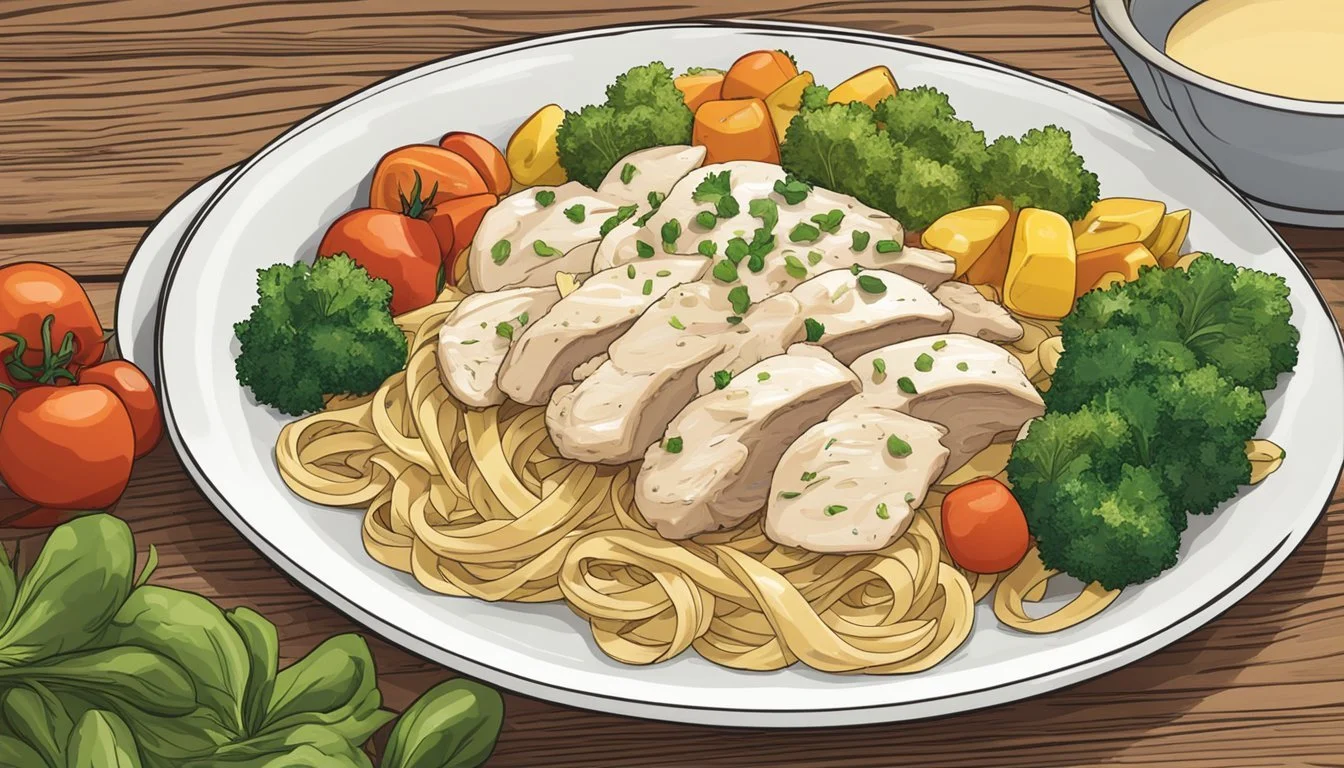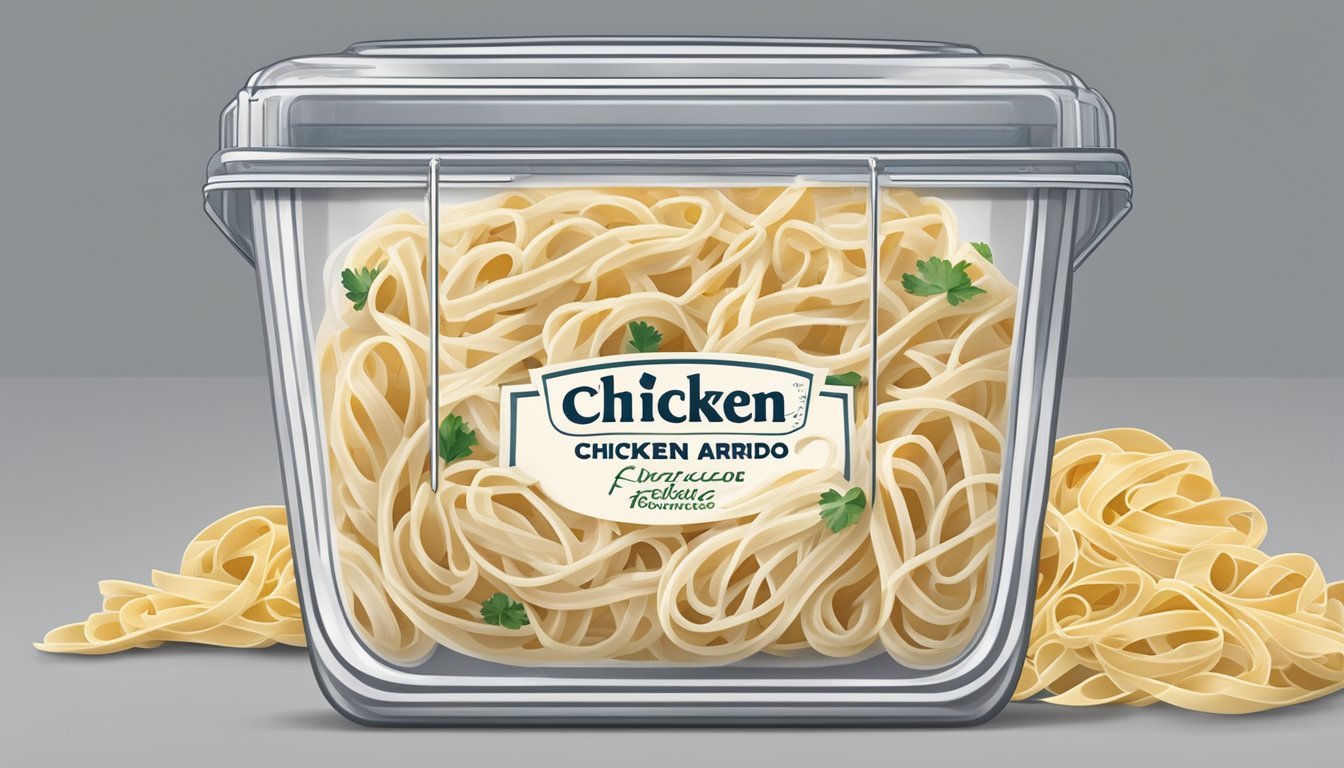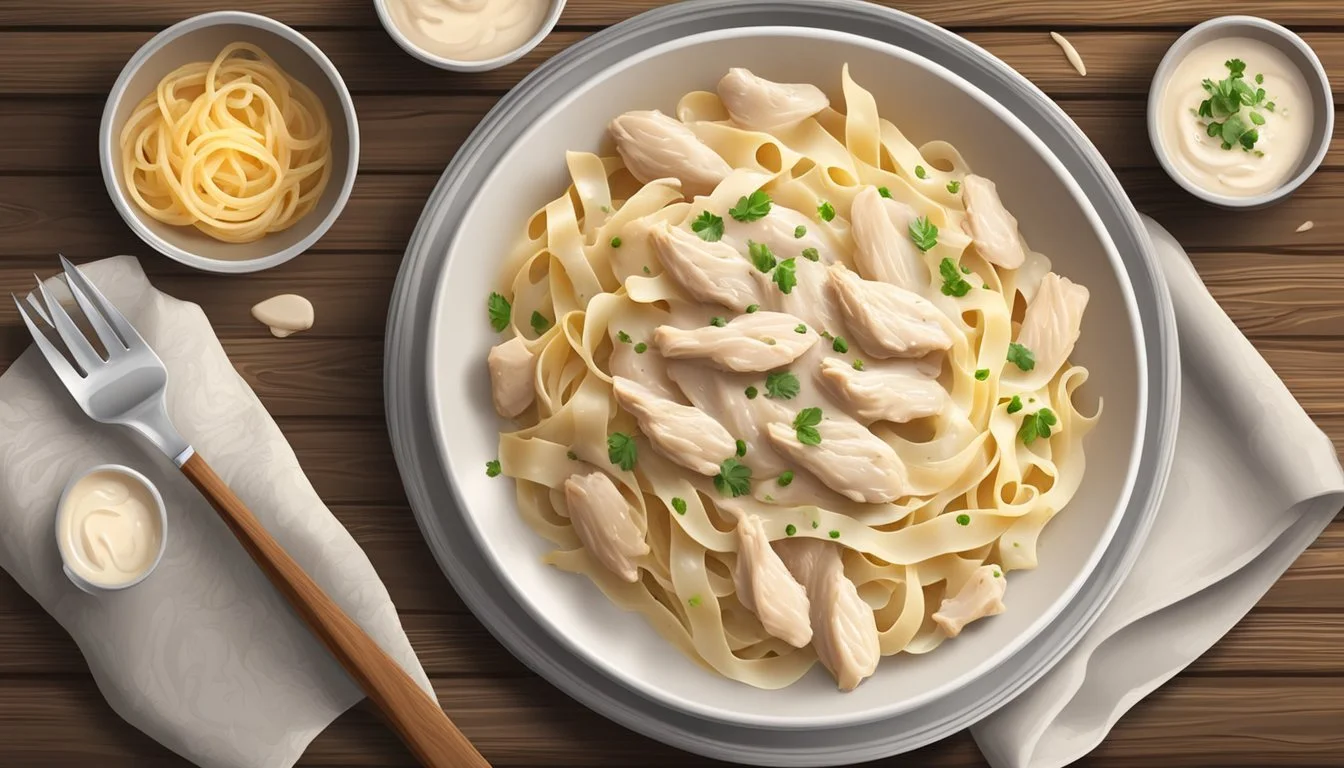How Long Does Chicken Fettuccine Alfredo Last?
Storage Tips and Shelf Life
Chicken Fettuccine Alfredo, a beloved pasta dish known for its creamy Alfredo sauce and tender chicken, is often a favorite for leftovers. When properly stored, Chicken Fettuccine Alfredo lasts in the refrigerator for about three to four days. Ensuring the dish is cooled completely before refrigerating can help maintain its quality and prevent bacterial growth.
Refrigerating this dish in an airtight container preserves its flavor and texture. For those wondering about freezing, cooked Chicken Fettuccine Alfredo can be kept in the freezer for up to two to three months, though slight changes in texture may occur. Be sure to revive it carefully to enjoy a delightful meal even days later.
Food safety is paramount, so it’s crucial to avoid leaving Chicken Fettuccine Alfredo unrefrigerated for more than two hours. This prevents harmful bacteria from developing. This quick guide will offer valuable tips for storing, reheating, and enjoying your leftover Chicken Fettuccine Alfredo safely.
Composition and Nutritional Profile
Chicken Fettuccine Alfredo combines ingredients that provide a rich taste and a substantial calorie count. Understanding the components and their nutritional contributions is crucial for assessing its dietary impact.
Ingredients Breakdown
Chicken Fettuccine Alfredo is typically made with pasta, chicken, heavy cream, butter, Parmesan cheese, and various seasonings.
Pasta: The base, usually made from durum wheat, provides carbohydrates.
Chicken: Adds protein and varies depending on whether it's grilled, baked, or fried.
Heavy Cream and Butter: Contribute to the rich, creamy texture and are the main sources of fat.
Parmesan Cheese: Enhances flavor and adds protein, fat, and calcium.
Seasonings: Garlic, salt, and pepper are common, adding flavor without significant calories.
Nutritional Information
A typical serving of Chicken Fettuccine Alfredo is calorie-dense and high in fat.
Calories: Around 1191 calories per serving.
Protein: Approximately 36 grams, primarily from chicken and cheese.
Total Fat: About 81 grams, with 49 grams being saturated fat.
Carbohydrates: Roughly 88 grams, provided mostly by the pasta.
Cholesterol: High, mostly from the cream and cheese.
Sodium: Moderately high, depending on added salt and cheese.
Vitamins and Minerals: Contains calcium from cheese and small amounts of iron and potassium.
Chicken Fettuccine Alfredo is rich in macronutrients but should be consumed in moderation due to its high levels of fat and calories.
Proper Storage Techniques
Proper storage of chicken fettuccine Alfredo ensures its freshness and safety for consumption. It's crucial to refrigerate or freeze the dish to extend its shelf life and prevent bacterial growth.
Refrigerating Chicken Fettuccine Alfredo
To refrigerate chicken fettuccine Alfredo, start by allowing the dish to cool completely. Transfer the cooled pasta into airtight containers to prevent moisture and bacteria from entering. Properly stored, the dish can last in the refrigerator for 3-4 days. Maintain your refrigerator at or below 40°F (4°C) for optimal food safety. Label the containers with the date of storage to keep track of freshness.
Ensure the refrigerator door is firmly closed to keep a consistent temperature. Avoid storing the Alfredo in the fridge door, as this area is subject to temperature fluctuations. Instead, place it on a middle or lower shelf.
Freezing Chicken Fettuccine Alfredo
When freezing chicken fettuccine Alfredo, begin by dividing the dish into portion-sized amounts. Place these portions into airtight containers or freezer bags. Ensure all excess air is removed from the bags to prevent freezer burn. Label the containers or bags with the date to monitor storage time.
Chicken fettuccine Alfredo can be safely stored in the freezer for 2-3 months. Keep your freezer at 0°F (-18°C) or lower. When ready to eat, thaw the Alfredo in the refrigerator overnight. Reheat thoroughly to an internal temperature of 165°F (74°C) before serving to ensure food safety.
Additional precautions include avoiding repeated freezing and thawing, which can affect texture and flavor. For best results, freeze the Alfredo as soon as possible after cooking.
Shelf Life Determination
The shelf life of chicken fettuccine Alfredo depends on how it is stored. Proper storage conditions can prevent harmful bacterial growth and extend its usability.
Refrigerated Shelf Life
Refrigerated chicken fettuccine Alfredo can last for 3-4 days if stored correctly. Maintaining a refrigerator temperature of 40°F (4°C) or below is crucial. Use airtight containers to minimize exposure to air and moisture.
Signs of spoilage such as mold growth, off smells, and changes in texture indicate it is unsafe to eat. Reheating the dish to an internal temperature of 165°F (74°C) kills any harmful bacteria developed during storage.
Frozen Shelf Life
When frozen, chicken fettuccine Alfredo can last for 2-3 months. Freezing at 0°F (-18°C) or lower maintains the dish's quality and safety. Using freezer-safe, airtight containers or heavy-duty aluminum foil helps prevent freezer burn and preserves taste.
Thawing should be done in the refrigerator or using a microwave. Once thawed, consume the dish within 1-2 days and reheat to 165°F (74°C) before eating to ensure food safety.
Factors Affecting Shelf Life
Several factors can impact the shelf life of chicken fettuccine Alfredo:
Temperature: Consistent cool temperatures slow microbial growth.
Storage Conditions: Proper use of airtight containers reduces moisture and contamination.
Bacterial Growth: Fast-growing bacteria like Salmonella and E. coli thrive at room temperature.
Handling Practices: Prompt refrigeration after cooking and minimal exposure to open air prevents contamination.
Signs of Spoilage: Lookout for discoloration, sour smell, and slimy texture as indicators of spoilage.
Paying close attention to these factors helps ensure your chicken fettuccine Alfredo remains safe and delicious to eat. Ensure adherence to recommended storage practices for peak quality.
Safe Reheating Methods
When reheating chicken fettuccine alfredo, it's crucial to ensure it heats evenly and reaches a safe internal temperature of 165°F (74°C) to avoid any foodborne illnesses. Here are the safest and most effective methods for reheating this dish.
Microwave Reheating
The microwave offers a quick and convenient method for reheating chicken fettuccine alfredo. Begin by placing the pasta in a microwave-safe dish. Add a tablespoon of water, milk, or a dab of butter to help maintain the sauce's creamy consistency. Cover the dish with a microwave-safe lid or plastic wrap to trap moisture.
Heat the pasta at medium power for one minute. Remove, stir, and check the temperature. If not heated through, continue microwaving in 30-second intervals, stirring each time. This ensures the dish heats evenly and the chicken reaches the necessary internal temperature of 165°F (74°C).
Stovetop Reheating
For stovetop reheating, use a skillet or large pan over medium heat. Add the chicken fettuccine alfredo to the skillet and pour in a splash of water, milk, or cream. Stir the pasta continuously to prevent sticking and to evenly distribute heat.
As the pasta warms, monitor its texture, adding more liquid if it begins to dry out. Ensure all parts of the dish reach an internal temperature of 165°F (74°C). Stirring frequently helps to maintain the creamy consistency of the alfredo sauce and ensures the chicken and pasta are heated through evenly.
Oven Reheating
Reheating in the oven is ideal for larger portions. Preheat the oven to 375°F (190°C). Transfer the chicken fettuccine alfredo to an oven-safe dish. To prevent the pasta from drying out, add a tablespoon of water or milk and mix well. Cover the dish with aluminum foil.
Place the dish in the preheated oven for about 15-20 minutes. Halfway through, stir the pasta to ensure even reheating. Check the internal temperature to confirm it reaches 165°F (74°C). If necessary, continue heating in 5-minute increments until the dish is uniformly hot and creamy.
Maximizing Taste and Texture
Proper storage and reheating can significantly affect the taste and texture of chicken fettuccine alfredo. Following critical steps helps preserve the creaminess and enhance the flavors of this dish.
Handling Leftovers
To keep chicken fettuccine alfredo tasting fresh, ensure it is stored correctly. Cool the dish completely before refrigerating to prevent bacterial growth. Place the alfredo in an airtight container and store it in the refrigerator for 3-4 days. For longer storage, freezing is an option, though it may alter the texture. Wrap the dish tightly with aluminum foil or place it in a freezer-safe bag, ensuring as little air as possible surrounds it.
Reheating properly is crucial to retaining its creaminess. Heat the pasta gently over low heat, stirring frequently. Adding a splash of heavy cream or milk can help restore the sauce's consistency.
Enhancing Flavor After Storage
To rejuvenate stored chicken fettuccine alfredo, consider enhancing its flavors with a few simple steps. Seasoning is key; a pinch of salt and freshly ground black pepper can revive the flavors. Adding fresh garlic sautéed in butter before reheating can also brighten the taste.
For additional richness, sprinkle some grated Parmesan cheese on top before serving. If the sauce appears too thick post-reheating, incorporating a bit of warm heavy cream can bring back its silky texture. By carefully handling leftovers and paying attention to seasoning, the dish can maintain its delicious, creamy profile even after a few days in the fridge.
Culinary Variations and Additions
Chicken Fettuccine Alfredo is versatile and can be customized easily. The key points include exploring different types of pasta, adding various vegetables, and incorporating other meats and seafood for enhanced flavors.
Alternative Pasta Options
Different pasta shapes can greatly alter the texture and experience of Chicken Fettuccine Alfredo. While traditional recipes use fettuccine, spaghetti and angel hair provide a lighter, more delicate texture. Penne is another strong contender, offering a firm bite and a unique way for the sauce to cling to the pasta. These alternatives can be used according to personal preference or dietary needs, ensuring the dish feels fresh and customizable while maintaining rich flavors.
Vegetable Add-Ins
Adding vegetables not only increases nutritional value but also introduces different textures and flavors. Broccoli is a popular choice, adding a slight crunch and a complementary flavor to the creamy Alfredo sauce. Peas are another common addition, offering a sweet and tender contrast to the richness of the dish. Asparagus can impart a slightly nutty flavor and a vibrant color, making the plate more visually appealing. These vegetable add-ins are typically blanched or sautéed before being mixed into the final dish.
Meat and Seafood Enhancements
In addition to chicken breasts, other proteins can elevate Chicken Fettuccine Alfredo. Bacon adds a smoky, crispy element to the dish, providing a delightful contrast to its creaminess. Ham serves as a subtle, meaty addition with a hint of sweetness. For those who enjoy seafood, shrimp makes for a sophisticated Shrimp Alfredo variation, bringing mild briny flavors that pair excellently with the rich sauce. Experimenting with these proteins can transform the dish, adding depth and complexity to each bite.
Recipe Tips for Homemade Excellence
Achieving the perfect Chicken Fettuccine Alfredo requires attention to both the chicken and the Alfredo sauce. Here's how to excel in both areas to create a family favorite that will impress on weeknights.
Cooking the Perfect Chicken Fettuccine Alfredo
To achieve tender chicken, start by patting the chicken dry with paper towels. This ensures a superior sear. Season it generously with kosher salt, black pepper, and a bit of smoked paprika.
Heat olive oil in a skillet over medium-high heat. Add the chicken, cooking for approximately 5-7 minutes on each side until it reaches an internal temperature of 165°F. Remove and let it rest before slicing. This step locks in juices, resulting in moist, flavorful chicken.
While cooking the chicken, prepare the fettuccine noodles. Boil them in well-salted water until al dente. Drain, but keep a bit of the pasta water. This starchy liquid can help to emulsify the sauce later.
Creating a Creamy and Flavorful Alfredo Sauce
Melt butter in the skillet used for the chicken, enhancing the sauce with any remaining drippings. Quickly sauté minced garlic or garlic powder until fragrant. Add whole milk and heavy cream, stirring continuously.
For a creamy white sauce, add freshly grated Parmesan cheese. It's crucial to use freshly grated cheese as pre-grated types often contain anti-caking agents that can result in a grainy texture.
Incorporate a small amount of cream cheese for extra richness and smoothness. Season the sauce with kosher salt, black pepper, and a dash of nutmeg. Simmer until it reaches the desired consistency.
Combine the sauce with the cooked fettuccine and sliced chicken. Allow the pasta to soak up the flavors. Garnish with freshly chopped parsley for a touch of color and freshness. For those who enjoy extra sauce, adjust the proportions as needed to ensure a decadent finish.
Conclusion
When storing chicken fettuccine Alfredo, refrigeration is crucial. Properly stored in an airtight container, this dish will last 3-4 days in the fridge. This applies to both homemade versions and those from places like Olive Garden.
For longer storage, chicken Alfredo can be frozen. In the freezer, it remains good for 2-3 months. To maintain quality, seal it well to prevent freezer burn.
It's important to cool the pasta completely before refrigerating. This step helps prevent bacterial growth. Never leave chicken Alfredo unrefrigerated for more than 2 hours.
In summary:
Refrigerated: 3-4 days
Frozen: 2-3 months
This ensures safety and maximizes the dish's shelf life.







